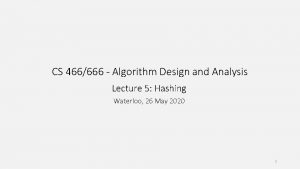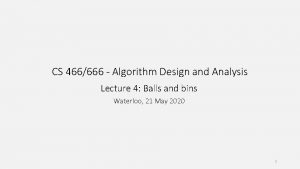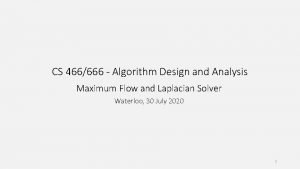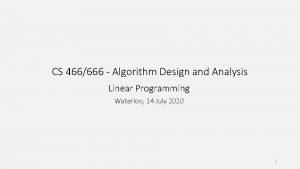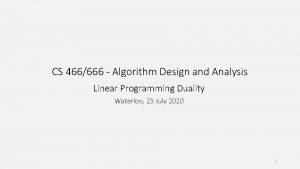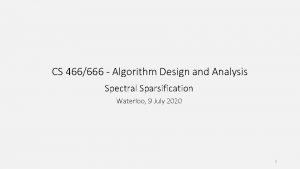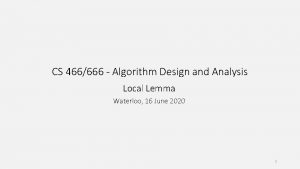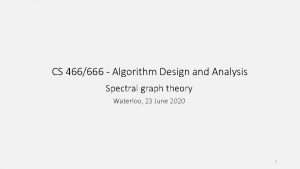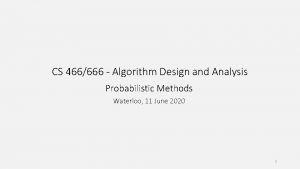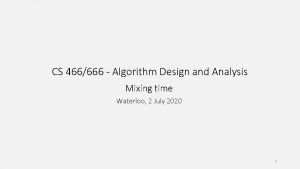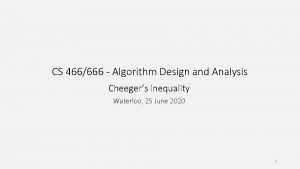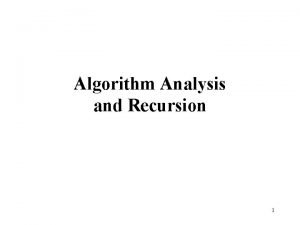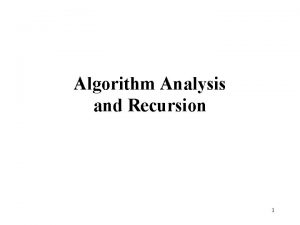CS 466666 Algorithm Design and Analysis Lecture 5






















- Slides: 22

CS 466/666 - Algorithm Design and Analysis Lecture 5 and 6: Hashing and Data Streaming Waterloo, 28 May 2020 1

Today’s Plan Finishing hashing using universal family TA office hour, Wed 11 am-12 pm, Fri 10 pm-11 pm. Perfect hashing HW 2 will be posted on Friday. Reporting heavy hitters HW difficulty? 2

Universal Hash Functions 3

Hashing Using 2 -Universal Family 4

Maximum Load We cannot guarantee that the maximum load is O(log(n)/loglog(n)) anymore. We say a pair of elements i, j is a collision pair if i≠j but h(i)=h(j). 5

Maximum Load We cannot guarantee that the maximum load is O(log(n)/loglog(n)) anymore. To guarantee that the maximum load is O(log(n)/loglog(n)), we say use a O(log(n)/loglog(n))-universal hash family (why? ). But this is not a good tradeoff. 6

Summary 7

Perfect Hashing Given a fixed set S of m keys, we would like to build a data structure for searching with excellent worst case guarantee (e. g. think of building a static dictionary, Wikipedia, etc). Convince yourself that it is not an easy problem. A hash function is perfect if it takes O(1) word operations to find an item or determine that it does not exist (again assuming each key can be stored in a word). 8

Observation The first observation is that perfect hashing is easy if we use more space. Lemma. If we choose a random hash function h from a 2 -universal family mapping the universe into a table of size n, then, for any set S of size m with n ≥ m 2, the probability that h is perfect for S is at least 1/2. We expect to find such an h by trying a constant number of hash functions from the family. 9

Two Level Hashing 10

Analysis Theorem. The two level approach gives a perfect hashing scheme for m items using O(m) bins. 11

Analysis Theorem. The two level approach gives a perfect hashing scheme for m items using O(m) bins. 12

Complexity Space requirement: total O(m) cells for the hash tables (first level table + second level tables). store at most m+1 hash functions, each requiring O(1) cells. so total storage is still O(m) cells. Time requirement: use two hash functions for each search operation. one first level hash function + one second level hash function. each requiring O(1) operations, so total O(1) operations. Overall, this is like building an array for the m keys, even though they come from a large universe. 13

Further References People don’t use k-universal family for hashing. Some simple hash family (e. g. tabulation hashing, cuckoo hashing) works well in practice and in theory. These are good topics for project. k-wise independence and “almost” k-wise independent variables are useful in derandomization (e. g. a standard tool in derandomizing “fixed parameter algorithms”). 14

Sublinear Algorithms Massive data set, can’t afford to read once or store all the data. Like to design sublinear time or sublinear space algorithms with nontrivial guarantees. Randomness is crucial, most tasks are impossible in the deterministic setting. We study some sublinear space algorithms, in the data streaming setting. For example, a router can’t store all the traffic data but still like to have some useful statistics. We will see three examples in the data streaming setting, one today and two next time. 15

Heavy Hitters 16

Objective 17

Hash Tables 18

Algorithm 19

Analysis 20

Analysis 21

Summary
 01:640:244 lecture notes - lecture 15: plat, idah, farad
01:640:244 lecture notes - lecture 15: plat, idah, farad Anany levitin
Anany levitin Brute force in design and analysis of algorithm
Brute force in design and analysis of algorithm System and form design
System and form design Hananel hazan
Hananel hazan User interface design in system analysis and design
User interface design in system analysis and design Dialogue design in system analysis and design
Dialogue design in system analysis and design Structured analysis approach
Structured analysis approach Which of the following is not a fact finding technique
Which of the following is not a fact finding technique System analysis and design project proposal example
System analysis and design project proposal example Line sweep algorithm
Line sweep algorithm Reinforcement lap lengths eurocodes
Reinforcement lap lengths eurocodes Elemen urban design
Elemen urban design Principles of design in interior design ppt
Principles of design in interior design ppt Lecture hall background
Lecture hall background Game design lecture
Game design lecture Computer-aided drug design lecture notes
Computer-aided drug design lecture notes Cmos vlsi design lecture notes
Cmos vlsi design lecture notes Exploratory data analysis lecture notes
Exploratory data analysis lecture notes Sensitivity analysis lecture notes
Sensitivity analysis lecture notes Factor analysis lecture notes
Factor analysis lecture notes Analysis of algorithms lecture notes
Analysis of algorithms lecture notes Streak plate method performed on
Streak plate method performed on



























